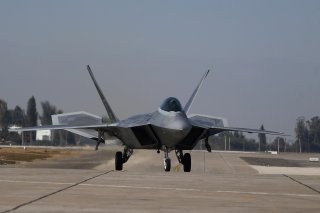These Upgrades Will Keep The F-22 Combat Ready Through 2060
The F-22 has become relevant again.
Key point: While the F-22 airframe is perhaps the most capable “chassis” in service in the USAF, with vectored thrust and supercruise capability, its stealth nature makes it hard to add on additional sensors and pods without compromising the stealth characteristic.
While much attention has been focused recently on the F-35 and F-15X, not much has been given to the U.S. Air Force’s premier air superiority fighter, the F-22 Raptor.
While the Raptor was one of the most advanced aircraft in the world when it entered service in the early 2000s, sensor, radar, and datalink technology have all advanced since then.
The Raptor has received relatively few upgrades compared to legacy fourth generation F-15 and F-16 aircraft and now is significantly outdated in some ways. For example, F-16s, F-15s, and F/A-18s are all equipped with the JHMCS missile cueing technology, which allows a pilot to lock onto an aircraft just by looking at it. The F-22 currently does not have this capability.
The USAF, until now, has been largely pursuing a strategy of upgrading the F-22 via software, allowing the F-22 to more effectively use sensors it already has while incorporating minor hardware upgrades to allow for the integration of new weapons. But is this strategy sustainable as radars and electro-optical sensors get more powerful and smaller?
The answer is complicated. While the F-22 airframe is perhaps the most capable “chassis” in service in the USAF, with vectored thrust and supercruise capability, its stealth nature makes it hard to add on additional sensors and pods without compromising the stealth characteristics, limiting its ability to be upgraded. The shutdown of F-22 manufacturing facilities in 2011 also limited the upgrade potential of the F-22.
So how does the military plan to solve this? The latest upgrade for the F-22 comes in two parts: a hardware and a software upgrade. The upgrades are called Baseline 3.2B and Update 6. They have a couple goals: integrate the latest air-to-air missiles and improve the networked warfare capability of the F-22.
These upgrades are the first step to fully integrating the AIM-9X and AIM-120D air-to-air missiles into the avionics of the F-22. The AIM-9X was planned to be integrated onto the F-22 since 2014, but the upgrade has been continuously pushed back.
The missile itself was finally integrated in 2017, but it the JHMCS that is meant to be paired with it was not integrated. The latest upgrade will finally add a JHMCS-style helmet to the F-22. Conversely, other USAF and U.S. Navy aircraft have been using AIM-9X with JHMCS since the early 2010s.
The upgrades also add new crypto technology to the F-22, a critical upgrade given how the F-22 is expected to work in hostile electronic warfare environments. This is paired with a “transmit” module for the Link-16 datalink, which would allow the F-22 to share as well as receive radar and other targeting data from other aircraft. The F-22 only had a “receive” Link-16 module earlier.
The success of the F-35 as a targeting aircraft of sorts that uses its superior sensor capability to create a battlefield picture and then pass it onto older aircraft probably prompted the USAF to install an enhanced datalink in the F-22.
The combination of the new datalink and new missiles will put the F-22 on parity with modernized fourth generation aircraft in weapons and networked warfare capability. The F-35 still remains ahead in sensor technology.
Funding for an F-22 sensor upgrade will only come later in the 2020s and is likely to include an electro-optical module similar to the F-35’s EOTS and DAS systems to operate in heavy jamming environments. Such an upgrade would mirror the F-15X, which recently received a similar system.
While the F-22 may have been allowed to fall behind the F-35 in a few aspects during the Iraq and Afghanistan wars, the military’s refocus on a peer or near-peer engagement has thrust the F-22 back into the spotlight again, with upgrades to match.
While such upgrades have been planned since 2013, they only recently have been fully funded and given priority with increased budgets in FY ’19. If all goes well, the F-22 will remain on the cutting edge of air superiority into the 2060s, at which point a sixth generation fighter is planned to take over.
Charlie Gao studied Political and Computer Science at Grinnell College and is a frequent commentator on defense and national security issues. This article first appeared earlier this year.
Image: Reuters.

